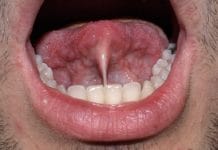Xerostomia or dry mouth is one of the most undermanaged oral health conditions in medicine and dentistry. This could be due to the lack of diagnosis and the lack of understanding about the oral implications associated with xerostomia. In addition to oral implications, many patients experience a decrease in quality of life that can potentially lead to depression. The etiology is diverse making the cause sometimes difficult to pinpoint. Often the cause is due to multiple factors, making management more difficult in some cases. Currently, treatment is palliative using salivary stimulants, topical agents, saliva substitutes, and systemic sialogogues.
The percentage of people reportedly affected by xerostomia is quite a wide range, anywhere from 1-29% of the population. A higher percentage of women are affected, and about half of the geriatric population complains of symptoms of xerostomia.1 Interestingly some patients that complain of dry mouth show no clinical signs of decreased saliva flow, this could indicate a change it the quality of saliva rather than the quantity. Xerostomia may affect speech, chewing, swallowing, and denture wearing.2 Malnutrition is a complication due to difficulty chewing, swallowing, and taste abberation.2,3
The etiology of xerostomia is multifactorial and includes medication induced, disease-related, aging, chemotherapy, radiation due to head/neck cancer, and lifestyle choices. According to the Surgeon General’s report, over 400 medications can contribute to reduced saliva flow.5 Of the top 20 medications prescribed, 15 have xerostomia as a side effect.4 Symptoms may be reduced if the medication can be taken in the morning rather than at night because the amount of saliva produced is highest during the waking hours and is drastically reduced during sleep.5,6 In some cases drug substitution may be an option (for example serotonin reuptake inhibitor antidepressants are reported to cause less dry mouth than tricyclic antidepressants). Taking medications in divided doses rather than one large dose may also help reduce xerostomia.5
The most well-known disease that contributes to xerostomia is Sjogren disease. Sjogren disease is the second most common autoimmune connective tissues disease; it affects 1 in 70 people. This number almost doubles in patients with other autoimmune diseases. Sjogren disease is not the only disease that contributes to xerostomia. Other diseases include cystic fibrosis, HIV, hepatitis C, lymphoma, and poorly controlled diabetes. This list is just a sample of the many systemic diseases that contribute to reduced salivary flow.5
In addition to autoimmune diseases and viruses, bacterial infections have been shown to play a role in xerostomia. Actinomycosis, a bacterial infection caused by several members of the bacterial genus Actinomyces is an example. These bacteria found in the mouth cause infection when they can multiply freely. Poor oral hygiene, periodontal disease, and damage to the oral mucosa are factors that contribute to actinomycosis. The bacteria can colonize in both submandibular and parotid glands leading to abscesses that block saliva flow.7
Aging is associated with the incidence of xerostomia. It is believed to be a factor due to the acquisition of systemic diseases as well as an increase in the number of medications needed as we age. Many older individuals experience a change in flavor perception; this can lead to reduced nutrient intake and malnutrition. Altered flavor perception in older individuals is contributed to the decrease of calcium and mucin content in their saliva. Therefore, it is important to consider that a patient complaining of dry mouth may not have a significant reduction in saliva flow, but the quality of the saliva could be the issue and should not be ignored.3
Xerostomia caused by chemotherapy or head and neck radiation can be acute or chronic. These procedures can cause toxicity directly to the saliva glands and surrounding oral tissue or through indirect damage from regional or systemic toxicity. Chemotherapy is usually associated with acute toxicity that resolves after treatment is complete and the tissues heal. Radiation is associated with acute oral toxicity that can often cause permanent tissue damage leading to chronic xerostomia. Certain stem-cell transplants used for cancer treatment have been linked to xerostomia. Radioactive iodine used to treat some thyroid cancers can damage salivary glands resulting in reduced salivary flow. Infection of the salivary glands during chemotherapy and/or radiotherapy is associated with acute toxicity and xerostomia as well.3
Certain lifestyle choices contribute to xerostomia. Use of alcohol, use of tobacco products, excessive consumption of spicy or salty foods and caffeine are associated with increased risk of xerostomia. Salt, spicy foods and caffeine are all diuretics that reduce salivary flow. Alcohol can also act as a diuretic when consumed in moderate amounts causing widespread dehydration including a reduction in salivary flow.8 Studies show long term smoking significantly reduces saliva flow and increases dental disease associated with xerostomia.9
Additional symptoms associated with xerostomia is an increased risk of developing cervical decay, mouth sores, chapped and cracked lips, bad breath, and a sore tongue and/or throat. Some patients develop burning mouth syndrome from chronic xerostomia. Developing a plan to minimize symptoms might include xylitol gum and candy to stimulate saliva flow and reduce cervical decay, sip water throughout the day, limit the consumption of caffeine, salty and spicy foods, and using lanolin-based lip balm to reduce cracked dry lips.10 Prescription medications such as cevimeline as well as over the counter and prescription saliva substitutes are also a great option to add to difficult to manage cases. Each patient is different, so each plan needs to be unique with recommendations that fit the patient’s needs.
Many patients may feel like xerostomia is just a nuisance that they will have to live with, but dental professionals know this is not the case. Managing symptoms of xerostomia not only improves quality of life, but it also improves oral health as well. I have personally seen patients lose their entire dentition from poorly managed xerostomia. The results were an ill-fitting denture, sore mouth, and poor nutrition leading to illness and severely decreased quality of life. In most cases this situation is avoidable; patient compliance is an important factor in a successful plan to manage xerostomia. Make sure you take the time to explain the benefits of managing acute and chronic xerostomia with your patients. They will certainly appreciate the relief and improved quality of life they will experience.
Resources
- Tanasiewicz, M., Hilderbrandt, T., Obersztyn, I. Xerostomia of Various Etiologies: A Review of the Literature. Adv Clin Exp Med. 2016; 25(1): 199-206. Retrieved from https://www.ncbi.nlm.nih.gov/pubmed/26935515
- Villa, A., Connell, C.L., Abati, S. Diagnosis and Management of Xerostomia and Hyposalivation. Ther Clin Risk Manag. 2015; 11: 45-51. Retrieved from https://www.ncbi.nlm.nih.gov/pmc/articles/PMC4278738/
- Xu, F., Laguna, L., Sarkar, A. Aging-related Changes in Quantity and Quality of Saliva: Where Do We Stand in Our Understanding? J Texture Stud. 2019 Feb; 50(1): 27-35. Retrieved from https://www.ncbi.nlm.nih.gov/pubmed/30091142
- Clinicians Report. Common Prescriptions Associated with Xerostomia. October 2012, Vol 5 Issue 10. Retrieved from https://www.cliniciansreport.org/uploads/files/55/Meds%20Cause%20Xerostomia.pdf
- American Dental Association. Oral Health Topics: Xerostomia (Dry Mouth). Retrieved from https://www.ada.org/en/member-center/oral-health-topics/xerostomia
- Thie, N.M., Kato, T., Bader, G., Montplaisir, J.Y., Lavigne, G.J. The Significance of Saliva During Sleep and the Relevance of Oromotor Movements. Sleep Med Rev. 2002 Jun; 6(3): 213-27. Retrieved form https://www.ncbi.nlm.nih.gov/pubmed/12531122
- Mortazavi, H., Baharvand, M., Movahhedian, A., Mohammadi, M., Khodadoustan, A. Xerostomia Due to Systemic Disease: A Review of 20 Conditions and Mechanisms. Ann Med Health Sci Res. 2014 Jul-Aug; 4(4): 503-510. Retrieved from https://www.ncbi.nlm.nih.gov/pmc/articles/PMC4160670/
- Kristel, C.M., Polhuis, M., Annemarthe, H.C. Wijnen, A.S., Calame, W., Tieland, M. The Diuretic Action of Weak and Strong Alcoholic Beverages in Elderly Men: A Randomized Diet-Controlled Crossover Trial. 2017 Jul; 9(7): 660. Retrieved from https://www.ncbi.nlm.nih.gov/pmc/articles/PMC5537780/
- Rad, M., Kakoie, S., Brojeni, F.N., Pourdamghan, N. Effect of Long-term Smoking on Whole-mouth Salivary Flow Rate and Oral Health. J Dent Res Dent Clin Dent Prospects. 2010 Autumn; 4(4): 110-114. Retrieved from https://www.ncbi.nlm.nih.gov/pmc/articles/PMC3429961/
- Mark, A.M. Limiting the Effects of Dry Mouth. JADA 2017. Retrieved from https://jada.ada.org/article/S0002-8177(17)30467-1/pdf












